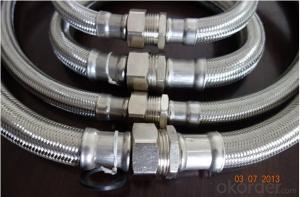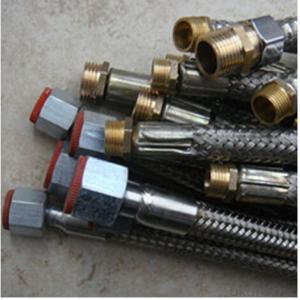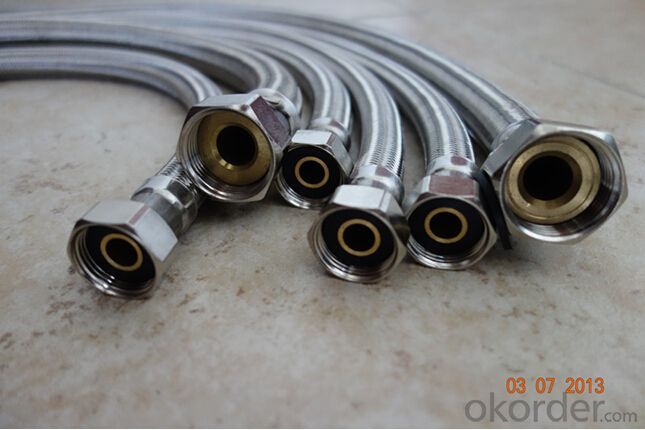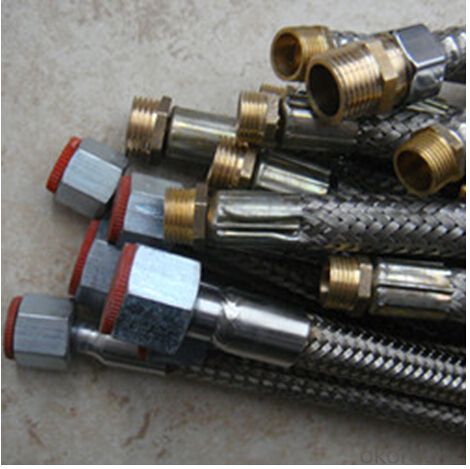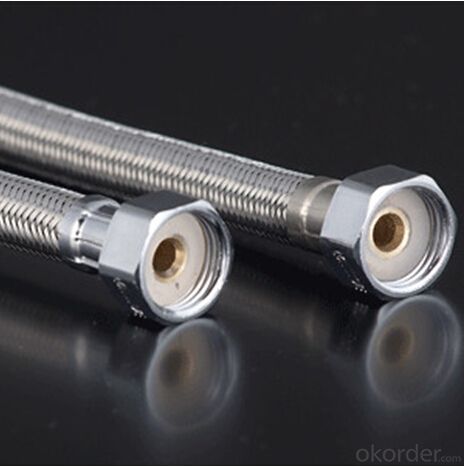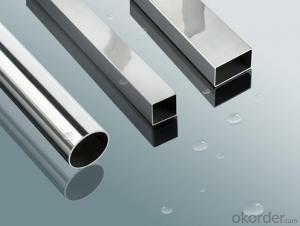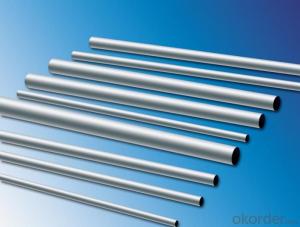Stainless Steel Braid Hose with Outside Fittings
- Loading Port:
- Tianjin
- Payment Terms:
- TT OR LC
- Min Order Qty:
- 1000 pc
- Supply Capability:
- 100000 pc/month
OKorder Service Pledge
OKorder Financial Service
You Might Also Like
Item specifice
Stainless Steel Braid Hose with Outside Fittings
Applications of Stainless Steel Braid Hose with Outside Fittings:
--Refueling system
--Chemical and pharmaceutical industry
--Industrial hydraulic systems
--Air conditioners in industrial and construction –site vehicles
--Food and beverage industry
--Special and standard industrial applications
--Water and cleaning management
Features of Stainless Steel Braid Hose with Outside Fittings:
1. )O. D.: 13-18MM 0.2-3M long
2. )Nut.: Nickel/Chrome Plated Brass (Zinc / Iron / Aluminum is available)
3. )Size Of Nut.: Female&Male 1/2''; 3/4''; 3/8''; 7/8''; 5/16'', and M10...
4. )Insert.: Brass (Zinc / Aluminum / Plastic is available)
5. )Inner tube.: Rubber/ EPDM/PVC
6. )Covered Material: Stainless Steel 201, 301, 304 /Aluminium Wire
7. )Working Pressure: 5Kg-15Kg
8. )Temperature: 0-92° C
9. )Quality Assurance: 3 years
RemarkAPPLICATION: HOUSEEHOLD WARE, BATHROOM WARE, SHOWER HOSE
PAYMENT: T/T, L/C
DELIVERY TIME: 20DAYS OR 30DAYS AFTER RECEIVED 30% DEPOSITS
MOQ: 5000PCS
ODM&OEM IS ACCEPTABLE
PackageInner: PP bag /Blister packing Outer: Carton box
Specifications of Stainless Steel Braid Hose with Outside Fittings:
NO | I.D | Refer to O.D | Working pressure | Burst pressure | approximate Weight | |||||
(inch) | (mm) | (inch) | (mm) | MPa | Psi | MPa | Psi | kg/m | lbs/ft | |
1 | 1/8 | 3.2±0.2 | 0.35 | 9±0.3 | 2.06 | 300 | 8.27 | 1200 | 0.078 | 0.12 |
2 | 5/32 | 4±0.2 | 0.4 | 10±0.3 | 2.06 | 300 | 8.27 | 1200 | 0.092 | 0.14 |
3 | 3/16 | 4.8±0.2 | 0.43 | 11±0.3 | 2.06 | 300 | 8.27 | 1200 | 0.108 | 0.16 |
4 | 1/4 | 6.3±0.3 | 0.5 | 12.7±0.3 | 2.06 | 300 | 8.27 | 1200 | 0.134 | 0.2 |
5 | 5/16 | 8.0±0.3 | 0.56 | 14±0.3 | 2.06 | 300 | 8.27 | 1200 | 0.147 | 0.22 |
6 | 3/8 | 9.5±0.3 | 0.63 | 16±0.4 | 2.06 | 300 | 8.27 | 1200 | 0.182 | 0.27 |
7 | 15/32 | 12±0.3 | 0.75 | 19±0.5 | 2.06 | 300 | 8.27 | 1200 | 0.238 | 0.35 |
8 | 1/2 | 12.7±0.4 | 0.78 | 20±0.5 | 2.06 | 300 | 8.27 | 1200 | 0.262 | 0.39 |
9 | 5/8 | 16±0.4 | 0.94 | 24±0.5 | 1.03 | 150 | 4.12 | 600 | 0.351 | 0.52 |
10 | 3/4 | 19±0.4 | 1.13 | 28.8±0.5 | 1.03 | 150 | 4.12 | 600 | 0.515 | 0.77 |
11 | 1 | 25.4±0.5 | 1.38 | 35±0.6 | 1.03 | 150 | 4.12 | 600 | 0.637 | 0.95 |
Images of Stainless Steel Braid Hose with Outside Fittings:
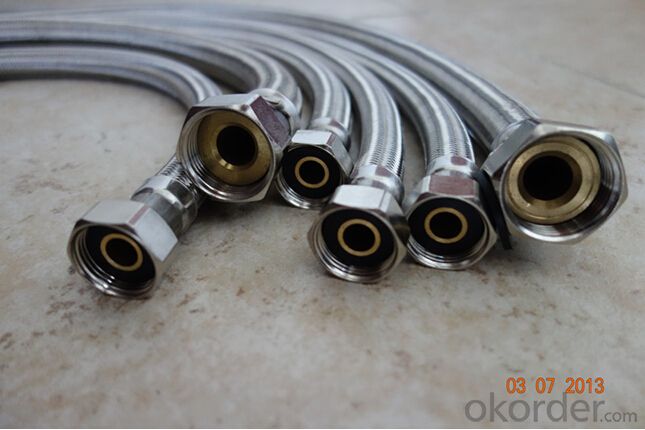
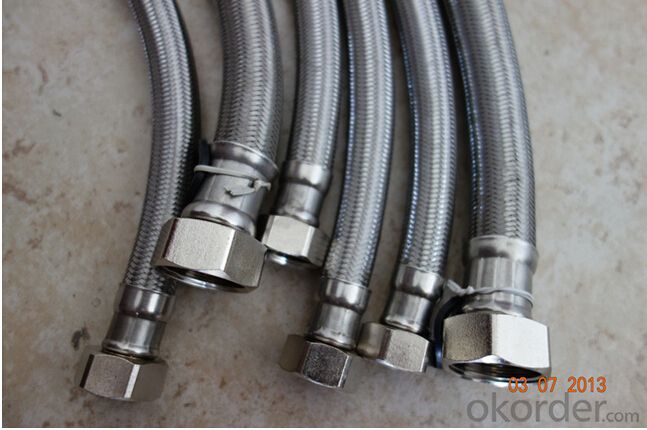
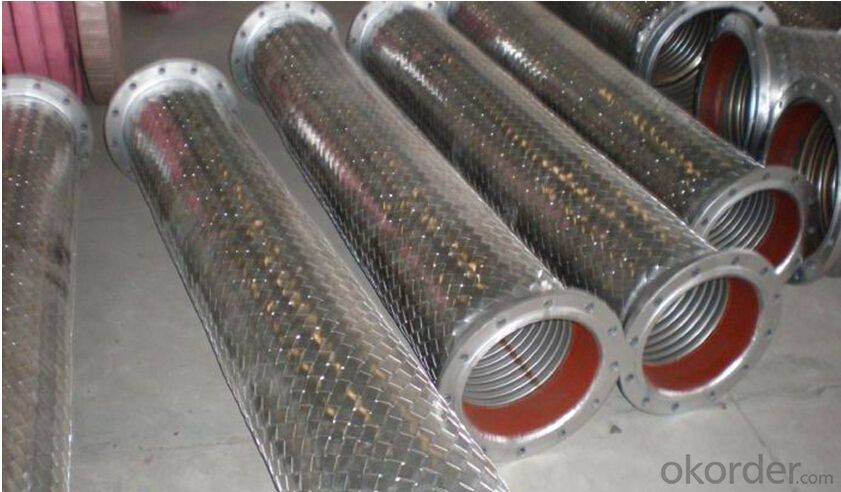
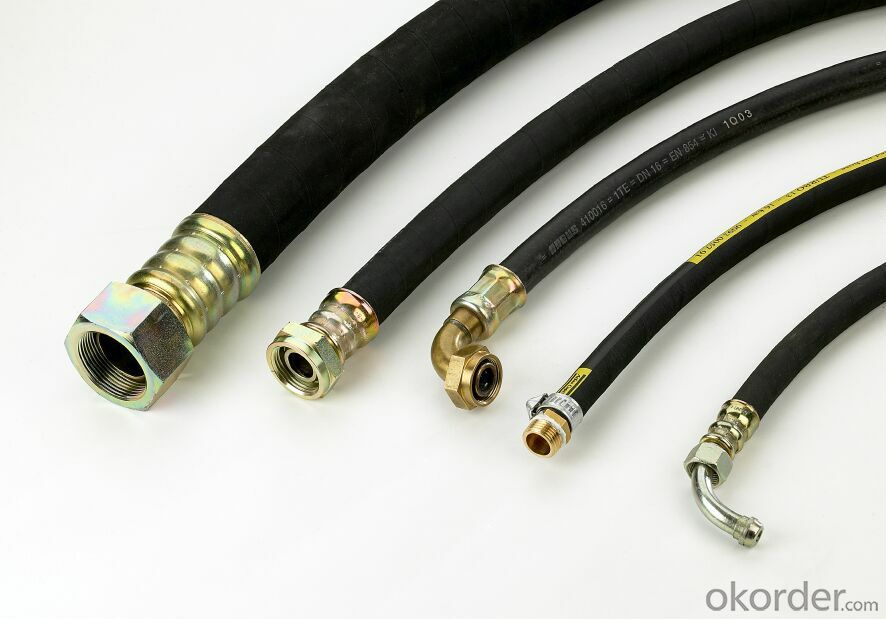
Package of Stainless Steel Braid Hose with Outside Fittings:
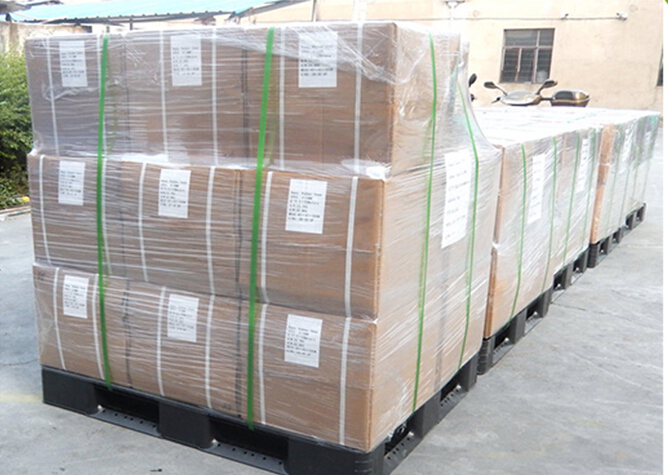
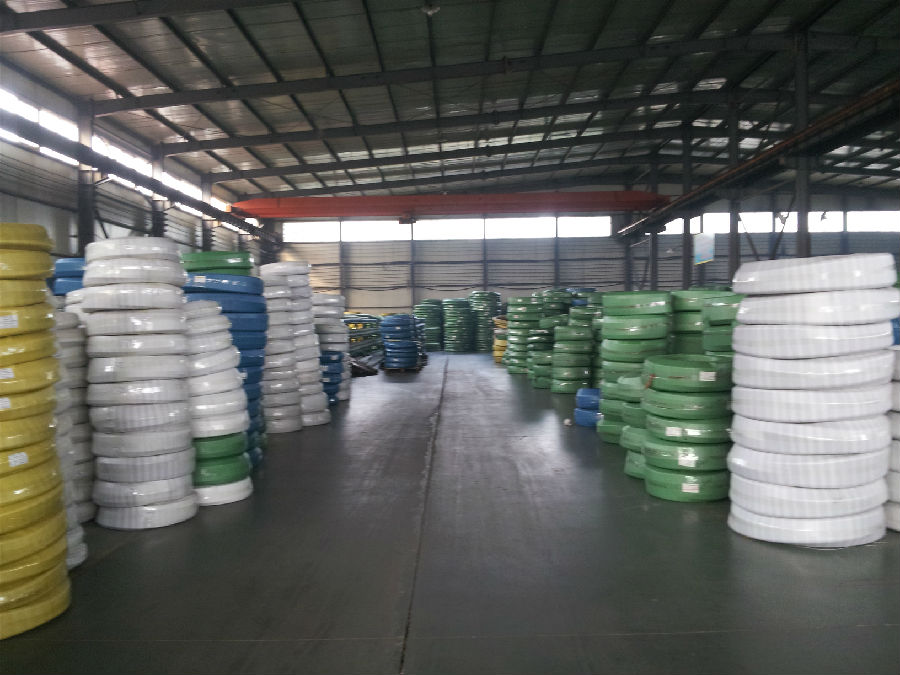
FAQ of Stainless Steel Braid Hose with Outside Fittings:
Who we are:
Answer: We CNBM is a Chinese state-owned enterprise ranked 267th among the Global Fortune 500, as the largest building materials company,we have over 300 affiliated companies,and so many production lines and branch office distribute in China.
2. About our quality:
Answer: Every product needs to be quality proved before shipping.
3. About our service:
Answer: We could gurantte that we can reply you in 2 working hours.
- Q:How do stainless steel pipes compare to titanium pipes?
- Stainless steel pipes and titanium pipes exhibit distinct characteristics, catering to diverse applications based on specific needs. In terms of strength, titanium pipes generally outperform stainless steel pipes. Titanium possesses an impressive strength-to-weight ratio, making it an ideal choice for lightweight yet strong materials. Conversely, stainless steel is renowned for its excellent tensile strength and durability, albeit being relatively heavier than titanium. Regarding corrosion resistance, both stainless steel and titanium pipes demonstrate high resistance to corrosion. Nevertheless, titanium pipes offer superior corrosion resistance, particularly in aggressive environments like seawater or chemical processing applications. Stainless steel pipes also possess good corrosion resistance but might require additional coatings or treatments to enhance their resistance in certain conditions. Temperature resistance is another crucial aspect to consider. Titanium pipes can endure high temperatures without compromising their strength or structural integrity, making them suitable for high-temperature applications in industries such as aerospace or power generation. Stainless steel pipes also exhibit decent heat resistance, but their performance may vary depending on the specific grade of stainless steel and the temperature range involved. Cost is an essential factor as well. Generally, stainless steel pipes are more cost-effective compared to titanium pipes. Titanium, due to its scarcity, intricate fabrication process, and higher production costs, is a pricier material. Hence, if cost is a significant consideration, stainless steel pipes emerge as a more viable option. In conclusion, stainless steel pipes and titanium pipes possess their own merits and aptitude for distinct applications. Titanium pipes excel in terms of strength, corrosion resistance, and heat resistance but come at a higher cost. Stainless steel pipes offer satisfactory strength, corrosion resistance, and cost-effectiveness. Ultimately, the selection between the two relies on the specific requirements, budget, and intended application of the pipes.
- Q:What is the difference between 304J8 and 316J8 stainless steel pipes?
- The primary distinction between stainless steel pipes of 304J8 and 316J8 lies in their composition and particular characteristics. 304J8 stainless steel, a widely utilized grade, is renowned for its exceptional resistance to corrosion, particularly in acidic and chloride environments. It boasts a higher chromium content (approximately 18-20%) and nickel content (around 8-10.5%), which contribute to its durability and resistance to corrosion. This grade finds suitability in various applications such as food processing, chemical industries, and architectural structures. On the contrary, 316J8 stainless steel represents an upgraded version of 304J8, featuring additional alloying elements. It possesses a higher chromium content (around 16-18%), nickel content (approximately 10-14%), and molybdenum content (around 2-3%). The introduction of molybdenum enhances its resistance against pitting and crevice corrosion, making it especially appropriate for marine environments or areas exposed to high chloride levels. As a result, 316J8 stainless steel pipes are commonly employed in seawater applications, chemical processing plants, and coastal structures. To summarize, the primary distinction between 304J8 and 316J8 stainless steel pipes is the inclusion of molybdenum in the latter, which imparts superior resistance to pitting and chloride corrosion. While both grades offer excellent corrosion resistance, the choice between them depends on the specific environment and application requirements.
- Q:Can stainless steel pipes be insulated with polyetherimide?
- Yes, stainless steel pipes can be insulated with polyetherimide. Polyetherimide (PEI) is a high-performance thermoplastic that has excellent thermal stability and insulating properties. It can be used as an insulation material for various applications, including pipe insulation. PEI offers good resistance to heat, chemicals, and electrical conductivity, making it suitable for insulating stainless steel pipes in different industries such as oil and gas, chemical processing, and aerospace. Additionally, PEI has a high glass transition temperature, which allows it to withstand high temperatures without melting or deforming, further enhancing its suitability for insulating stainless steel pipes.
- Q:Can stainless steel pipes be magnetized?
- Stainless steel pipes have the potential to be magnetized to some degree, although they are generally considered non-magnetic unlike ferromagnetic substances like iron or nickel. This is due to the presence of a substantial amount of chromium, which creates a protective oxide layer on the steel's surface, making it resistant to magnetization. Nevertheless, stainless steel can still exhibit a slight attraction to a magnet, particularly if it has undergone specific processes like cold working or welding. These procedures can alter the steel's crystalline structure, enabling it to acquire a slight magnetic quality. It is important to emphasize that the magnetic force in stainless steel pipes is relatively weak and will not possess the same level of magnetism or ability to attract other magnetic objects as ferromagnetic materials would.
- Q:What is the difference between 304J1 and 316J1 stainless steel pipes?
- The chemical composition and presence of certain elements distinguish 304J1 stainless steel pipes from 316J1 stainless steel pipes. 304J1 stainless steel is a variation of the well-known 304 stainless steel grade. It possesses a lower carbon content than regular 304, granting it increased resistance to intergranular corrosion. This is achieved by incorporating a small amount of titanium into the composition. 304J1 stainless steel pipes are suitable for a wide range of applications, including plumbing, food processing, and architectural uses. On the other hand, 316J1 stainless steel is a variation of the 316 stainless steel grade. It shares similarities with regular 316 stainless steel in terms of corrosion resistance, but it has a lower carbon content, similar to 304J1. Additionally, 316J1 contains a small amount of molybdenum, which enhances its resistance to pitting and crevice corrosion in chloride environments. As a result, 316J1 stainless steel pipes are commonly employed in marine environments, chemical processing plants, and other scenarios where exposure to corrosive substances is anticipated. To summarize, the primary disparity between 304J1 and 316J1 stainless steel pipes lies in their chemical composition, with the latter offering superior corrosion resistance in more aggressive environments. The selection between the two would hinge on the specific application and the desired level of corrosion resistance.
- Q:Are stainless steel pipes resistant to high temperatures?
- Yes, stainless steel pipes are generally resistant to high temperatures. Stainless steel is specifically designed to withstand high heat and maintain its structural integrity at elevated temperatures. The high chromium content in stainless steel forms a protective oxide layer on the surface, which helps to prevent corrosion and maintain its strength and durability even in extreme temperature conditions. This makes stainless steel pipes suitable for various applications that involve high temperatures such as industrial furnaces, heat exchangers, and exhaust systems. However, it is important to note that the specific resistance to high temperatures may vary depending on the grade and alloy of stainless steel used. Therefore, it is crucial to select the appropriate grade of stainless steel based on the specific temperature requirements of the application.
- Q:What are the maintenance requirements for stainless steel pipes?
- Compared to other materials, stainless steel pipes have relatively low maintenance requirements. However, to ensure their longevity and optimal performance, there are a few key steps that should be taken. To begin with, it is essential to regularly clean the pipes to remove any dirt, grime, or contaminants that may accumulate on the surface. This can be accomplished by using mild soap and water or a non-abrasive cleaner. It is crucial to avoid the use of abrasive materials or harsh chemicals as they can cause damage to the stainless steel surface. Periodically inspecting the pipes is also recommended to check for any signs of corrosion or damage. While stainless steel is known for its corrosion resistance, there are certain environments or conditions that can still make it susceptible. Addressing any signs of corrosion promptly is important to prevent further deterioration. Protecting the stainless steel pipes from physical damage or impact is another important factor. This can be achieved by avoiding heavy objects from hitting or rubbing against the pipes and using suitable padding or insulation in areas where they may be exposed to potential impact. Lastly, it is crucial to ensure that the stainless steel pipes are installed and used in accordance with their intended purpose and within their specified temperature and pressure limits. This will help prevent any unnecessary stress or strain on the pipes, which could result in premature failure. By adhering to these maintenance requirements, stainless steel pipes can offer long-lasting durability and performance in various applications.
- Q:Are stainless steel pipes suitable for paper mills?
- Yes, stainless steel pipes are suitable for paper mills. Stainless steel is highly resistant to corrosion and can withstand the harsh chemicals and high temperatures typically found in paper mill operations. It is also durable and long-lasting, making it an ideal choice for transporting various fluids and materials within the facility.
- Q:Are stainless steel pipes suitable for power plants?
- Yes, stainless steel pipes are suitable for power plants. Stainless steel is a corrosion-resistant material that can withstand high temperatures and pressures, making it an ideal choice for power plant applications. Power plants often handle fluids and gases at elevated temperatures and pressures, and stainless steel pipes offer excellent resistance to corrosion, erosion, and oxidation in such conditions. Additionally, stainless steel pipes have a long lifespan, require minimal maintenance, and offer good mechanical properties, making them reliable for power plant operations.
- Q:Stainless steel pipes can not be less than the amount of chromium
- General stainless steel chromium content is generally not less than 12%, high even up to 18%. Steel added elements such as chromium, can change the performance of the steel, such as the molecular structure of steel more uniform on the surface of the steel is more easily to form a layer of dense oxide protective film, thereby greatly improving the ability of corrosion-resistant stainless steel. Therefore, stainless steel can resist fire, water, acid, alkali and various solutions to its corrosion, not rust. The scientists found that the internal structure of the steel is more uniform, various components more closely linked to the corrosion of the more difficult the invasion, also attached to the surface with a layer of oxide film, like iron and steel to wear armor, was not naturally easy to rust. Why is stainless steel rust? When the stainless steel tube surface appear brown rust (point) when people are surprised: stainless steel does not rust, rust is stainless steel, steel may be a problem. In fact, this is a lack of understanding of stainless steel one-sided misconceptions. Stainless steel will rust under certain conditions. Stainless steel has the ability to resist atmospheric oxidation - that is, stainless steel, and also has the ability to corrode in medium containing acids, alkalis, and salts - that is, corrosion resistance. But its corrosion resistance is changed with the chemical composition, the mutual state, the condition of use and the type of environmental medium.
1. Manufacturer Overview |
|
|---|---|
| Location | |
| Year Established | |
| Annual Output Value | |
| Main Markets | |
| Company Certifications | |
2. Manufacturer Certificates |
|
|---|---|
| a) Certification Name | |
| Range | |
| Reference | |
| Validity Period | |
3. Manufacturer Capability |
|
|---|---|
| a)Trade Capacity | |
| Nearest Port | |
| Export Percentage | |
| No.of Employees in Trade Department | |
| Language Spoken: | |
| b)Factory Information | |
| Factory Size: | |
| No. of Production Lines | |
| Contract Manufacturing | |
| Product Price Range | |
Send your message to us
Stainless Steel Braid Hose with Outside Fittings
- Loading Port:
- Tianjin
- Payment Terms:
- TT OR LC
- Min Order Qty:
- 1000 pc
- Supply Capability:
- 100000 pc/month
OKorder Service Pledge
OKorder Financial Service
Similar products
New products
Hot products
Hot Searches
Related keywords
